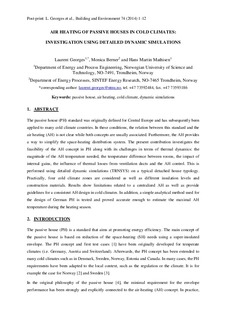Air heating of passive houses in cold climates: Investigation using detailed dynamic simulations
Journal article, Peer reviewed
Permanent lenke
http://hdl.handle.net/11250/2413778Utgivelsesdato
2014Metadata
Vis full innførselSamlinger
Sammendrag
The passive house (PH) standard was originally defined for Central Europe and has subsequently been applied to many cold climate countries. In these conditions, the relation between this standard and the air heating (AH) is not clear while both concepts are usually associated. Furthermore, the AH provides a way to simplify the space-heating distribution system. The present contribution investigates the feasibility of the AH concept in PH along with its challenges in terms of thermal dynamics: the magnitude of the AH temperature needed, the temperature difference between rooms, the impact of internal gains, the influence of thermal losses from ventilation ducts and the AH control. This is performed using detailed dynamic simulations (TRNSYS) on a typical detached house typology. Practically, four cold climate zones are considered as well as different insulation levels and construction materials. Results show limitations related to a centralized AH as well as provide guidelines for a consistent AH design in cold climates. In addition, a simple analytical method used for the design of German PH is tested and proved accurate enough to estimate the maximal AH temperature during the heating season.
